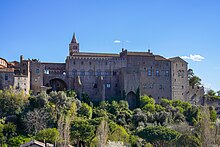
With a long history as a vantage point for anti-popes forces threatening Rome,[1] Viterbo became a papal city in 1243. During the later thirteenth century, the ancient Italian city of Viterbo was the site of five papal elections and the residence of seven popes and their Curias, and it remains the location of four papal tombs. These popes resided in the Palazzo dei Papi di Viterbo alongside the Viterbo Cathedral intermittently for two decades, from 1257 to 1281;[2] as a result, the papal palace in Viterbo, with that in Orvieto, are the most extensive thirteenth-century papal palaces to have survived.[3]
Shifting political and economic alliances pushed and pulled various popes of that century from Rome, taking refuge in other, not invariably hospitable, Italian city-states like Perugia and Orvieto. The primary cleavage in these divisions was between the Angevin and Hohenstaufen claimants to the title of Holy Roman Emperor, whom the pope could crown.
- ^ The Lombard king Desiderius and Frederick Barbarossa (who established his anti-papal there, are both noted by Edward T. Price, "Viterbo: landscape of an Italian city", Annals of the Association of American Geographers, 54.2 (June 1964:242-75) .
- ^ Cite error: The named reference
cewas invoked but never defined (see the help page). - ^ Gary M. Radke, "Medieval Frescoes in the Papal Palaces of Viterbo and Orvieto", Gesta, 1984; Radke, Viterbo: Profile of a Thirteenth Century Papal Palace, 1996.